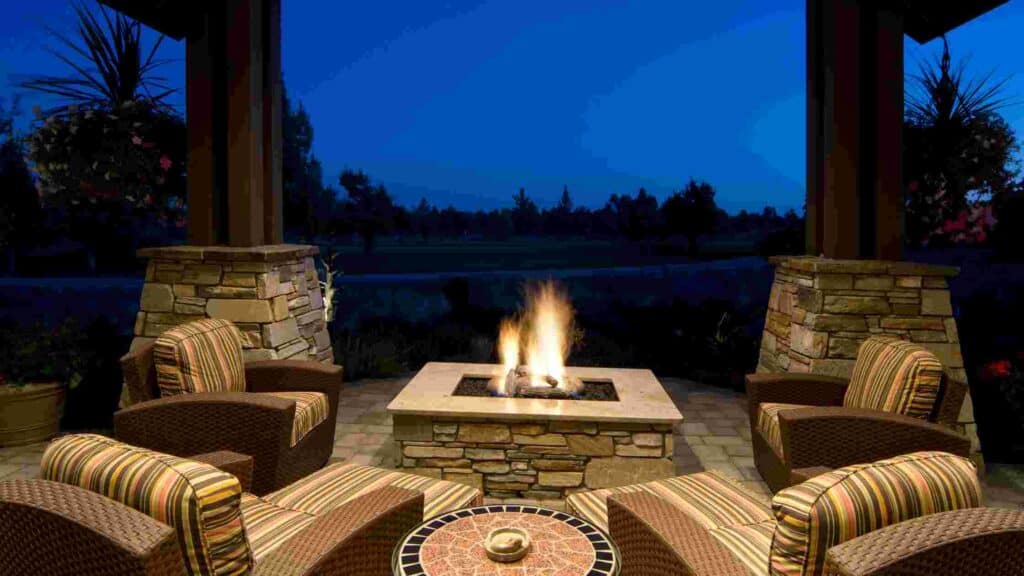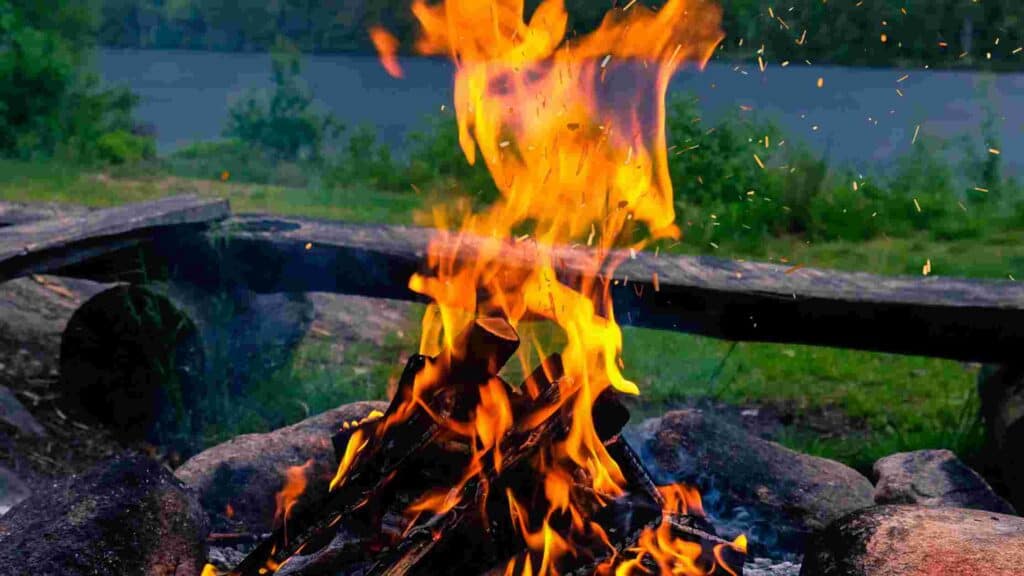Fire pits have become an essential addition to homes, transforming outdoor entertaining throughout the year. They provide warmth on chilly nights and offer the perfect setting for roasting marshmallows. Additionally, there is a therapeutic element in simply sitting and mesmerizingly watching the flickering flames. But how hot does a fire pit get?
It depends on the specific type of fire pit you own and the fuel you choose to burn.
A fire pit can reach temperatures ranging from 1,200 to 1,600 degrees Fahrenheit (650 to 870 degrees Celsius), depending on factors such as the type of fuel used and the airflow within the fire pit.
Factors Affecting Heat – How Hot Does A Fire Pit Get?
1. Temperature Considerations
The structure and materials used in constructing a fire pit significantly influence the temperatures it can attain. To build a fire, three essential components are required: fuel, oxygen, and heat.
When these elements combine, a chemical reaction occurs, resulting in the production of heat. For instance, wood needs approximately 16% oxygen to burn. As air naturally contains 21% oxygen, a well-formed wood fire is capable of generating extremely high temperatures.
In fact, a bonfire can reach scorching temperatures of up to 2012 degrees Fahrenheit (1100 degrees Celsius), which is sufficient to surpass the melting point of aluminum (you may also be interested in how to make a bonfire pit)
2. Different Varieties
Fire pits come in a wide variety of styles, sizes, and materials. You can opt for a lightweight metal bowl that can be easily placed anywhere or a fixed masonry structure ideal for patio gatherings.
The choice of the right product for you depends on factors such as frequency of use, placement location, budget constraints, and local regulations (read: Can you light a fire in your backyard without getting burned?).
It’s amazing to reflect on how we managed before fire pits became so popular!
3. Fuel Options
Some fire pit owners swear by crackling wood fires despite the accompanying smoke and ash. Others find the convenience of instant and controllable flames by simply flipping a switch more appealing.
While most fire pit styles blend well with lawn corners, those made from mortar masonry or tumbled concrete pavers tend to harmonize better with existing stonework when incorporated into a patio setting.
Choosing The Right Fuel Type

Similar to the diverse range of fire pits available, various fuel options cater to specific fire pit types.
Heat output in fire pits is measured in BTUs (British Thermal Units), a universal unit used to classify the heat generated by a range of products such as barbecue grills, fire pits, water heaters, and air conditioners.
Wood, charcoal, smokeless coal, fireplace ethanol, and gases like propane are all common fuel choices for fire pits.
Let’s explore the suitable fuel type that meets your heating needs.
How Hot Does A Wood Fire Pit Get?
Determining the exact temperature of wood fires is challenging due to the numerous variables that affect the heat generated from burning wood. Consequently, manufacturers rarely specify the heat produced by their wood fire pits as it would be an arbitrary figure.
However, existing data on wood fire temperatures can be used to estimate the heat output of a wood-burning pit. It is a well-known fact that fire bowls fueled primarily by wood reach higher temperatures compared to gas burners.
Wood burning entails two types of heat: the flames produced during wood combustion and the radiant heat emitted by the glowing logs and embers.
The temperature attained when burning wood can exceed 1000 degrees Fahrenheit, and the heat output can easily exceed 100,000 BTUs. These figures are influenced by the size of the fire bowl and the airflow surrounding the fire.
A larger fire bowl results in bigger flames and higher heat output. Adequate airflow also contributes to higher heat levels. Therefore, the position of your outdoor fire pit is a crucial factor in determining the amount of heat generated.
A centrally positioned fire pit will provide more warmth than one placed to the side or tucked away in a corner (here’s how far should a fire pit be from a house).
How Hot Does A Fireplace Get?
Gas fire pits utilizing bioethanol fuel are primarily designed for decorative purposes and are not recommended for outdoor use. These fire pits are usually smaller in size, resulting in a lower fuel capacity, smaller flames, and reduced heat output ranging from 1000 to 4000 BTUs.
While this amount of heat can create a cozy feeling inside an entertainment room, it may struggle to provide sufficient warmth if used outdoors, particularly on colder evenings.
How Hot Does A Propane Fire Pit Get?
Compared to wood-burning fire pits, those powered by propane are easier to ignite, offer controllable heat, and require minimal cleanup. Manufacturers of propane-fueled products typically advertise their heat ratings to compete in the market.
On the lower end of the scale, decorative propane fire pits produce around 10,000 BTUs, prioritizing style as much as heat generation. Moving up the scale, a range of propane fire pits is capable of reaching much higher temperatures.
The maximum heat output for a domestic gas-fueled product usually reaches approximately 70,000 BTUs.
How Hot Does A Gas Fire Pit Get?
Unlike propane, a gas fire pit is stationary as it is connected to a gas line from your house (find out how to light a gas fire pit).
Natural gas is approximately 1/6th the cost of propane in some regions and provides the advantage of an uninterrupted fuel supply.
However, propane is more efficient, generating about 2500 BTUs, while the same amount of natural gas produces only 1000 BTUs.
Fire Pit Costs
The price of fire pits varies depending on their specifications.
A 28-inch steel wood fire bowl can be purchased for as low as $50, while propane-burning fire pits typically start around $500 for a 46-inch model. Custom masonry fire pits of similar size can cost around $2,500.
Safety Measures For Using Your Outdoor Fire Pit

Installing a fire pit in your backyard is a nice way to enjoy outdoor activities during the colder winter months. However, it is essential to prioritize safety by following a few simple rules.
Placement
- Maintain a 10-foot distance from your neighbor’s yard.
- Position the fire pit at least 10 feet away from any structures or flammable vegetation, such as trees or grass.
- Do not position it directly on a wooden deck or on the grass (check out the article: Can you have a fire pit on a deck?).
- Avoid placing the fire pit under a low-hanging tree, pergola, or covered porch.
Ignition
- Do not use lighter fluid for ignition. Instead, use a commercial fire starter with kindling (learn how to start a fire in a fire pit).
- Always look for the wind direction before lighting the fire. Avoid lighting the fire pit in excessively windy conditions.
- Refrain from using any flammable fluids to light or reignite the fire.
Usage
- Keep children and pets away from the hot fire pit.
- Never leave the fire pit unattended, even for a brief moment. Extinguish the fire with water before leaving.
- Ensure everyone maintains a safe distance from the flames.
- Use an appropriate amount of fuel to keep the fire burning gently, avoiding excessive fuel consumption.
- Consider investing in a wire mesh cover to create a covered fire pit, preventing embers from escaping and protecting against accidental falls by children or pets.
- Keep a nearby hose and a container of water accessible in case of an emergency.
- Avoid wearing loose-fitting or flammable clothing while near the fire pit.
- Refrain from throwing garbage or paper products into the fire, as they can create sparks or burning remnants.
Extinguishing
Whenever you finish using your fire pit, it is crucial to completely extinguish the flames before leaving it unattended. Follow these steps to safely extinguish the fire:
- Drown the fire with water and stir it using a shovel to ensure complete extinguishment.
- Keep a shovel close by to quickly extinguish any escaping flames and put out the fire.
- Do not discard hot ashes in a compost pile, plastic or paper bag, cardboard box, or any other combustible material.
- Dispose of the ashes safely. Use a designated metal bucket for storing ash, as ashes can remain hot enough to cause a fire for a couple of days.
FAQs
1. How hot does an open fire get?
An open fire can reach temperatures up to around 1,100 degrees Fahrenheit (590 degrees Celsius).
2. Can you leave a fire pit burning overnight?
It is not recommended to leave a fire pit burning overnight due to safety concerns and the potential for uncontrolled spreading of the fire.
3. What are metal fire pits made of?
Metal fire pits are commonly made of materials such as steel, cast iron, or aluminum.
4. Can you use a fire pit heat deflector?
Yes, you can use a fire pit heat deflector. A fire pit heat deflector is a device designed to redirect and distribute heat evenly, creating a safer and more comfortable environment around the fire pit. It helps to protect surrounding surfaces from excessive heat and can be particularly useful when using the fire pit on decks or other sensitive areas.
5. What is a fire pit used for?
A fire pit is typically used for recreational purposes, such as providing warmth, creating ambiance, and for cooking food.
You may also be interested in checking out the best fire pit cooking grates.
Conclusion – How Hot Does A Fire Get In A Fire Pit?
The temperature of a fire pit can vary, typically ranging between 1,200 to 1,600 degrees Fahrenheit (650 to 870 degrees Celsius). The specific heat achieved depends on variables such as the type of fuel being used and the airflow within the fire pit.
An outdoor fire pit can serve as a cozy centerpiece for relaxed evenings with family and friends. However, it’s crucial to handle it with caution, as a fire pit can quickly become dangerous if not used properly.
Now that you’re aware of the necessary safety measures, all that’s left is to step outside and enjoy the comforting warmth it provides.
